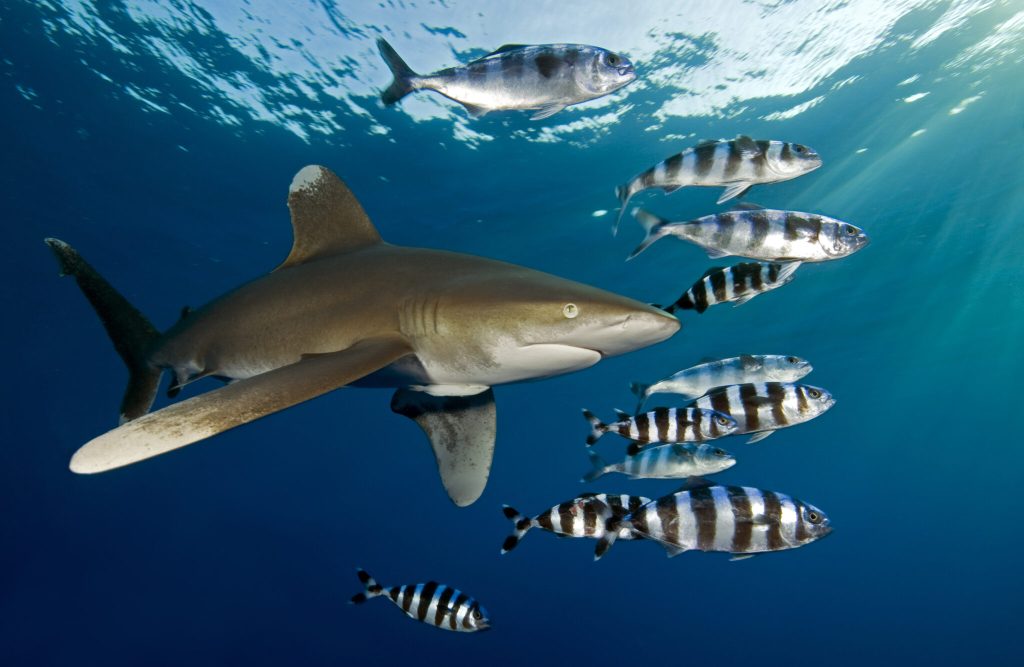An avid diver friend of mine who used to work for a pet store told me he’d noticed something interesting. Aside from divers and experienced aquarists, when talking about fish almost everyone said they knew nothing about them — except sharks. Everyone thought they knew about sharks. Similarly, you may have noticed that, thanks to movies and television, many people are certain they know a fair bit about sharks.
Misconceptions About Sharks
But as you likely guessed, most folk’s shark “knowledge” is wrong, hugely distorted or incomplete. When you start looking deeper (no pun intended) into the facts, sharks are arguably the most fascinating of all fish, and as PADI Ocean Torchbearers, we should be able to gently educate and advocate based on what’s true.
Contrary to the “man-eater” reputation, among about 500 species alive today, only 33 are known to have ever bitten a human – we’re not natural prey. You may have heard that lightening, bears and bees kill more people than sharks, and here’s a new one: lately, more people are killed taking selfies. For facts instead of fiction about shark attacks, check out the International Shark Attack File.
Scientists say that by controlling species populations, sharks may be the most important ocean predator – coral dies if there are too few sharks on a reef. There have been about 3000 species spanning more than 450 million years; they predate the dinosaurs, and unlike them, have survived five extinction events. In size, they range from the whale shark, the biggest of all fish (up to 12 m/40 ft long) to the dwarf lantern shark (only 15 cm/6 in long). They’re found in all oceans, from the surface to as deep as 3600 metres/12,000 feet.

Fascinating Shark Facts
Among other interesting shark facts, you’ve likely heard about sharks’ incredible sense of smell (they can detect 1 part blood in 1 million parts water), but that’s only the beginning. Most sharks can see 360º except just in front of their snouts or directly behind, and like cats, their eyes see especially well in low light. Like many fish, they have lateral lines head-to-tail on both sides that, by sensing minute changes in water pressure, detect other animals and even the reef. Finally, sharks have ampullae of Lorenzini, which allow them to detect electrical fields. This gives them a biological compass using Earth’s magnetic field, and because muscles produce electricity when they contract, a means to detect prey.
Unlike most other fish, some species reproduce by releasing egg pouches and others develop embryos internally similarly to mammals. Also unlike most other fish, sharks don’t reproduce often, and when they do, the female is pregnant for typically a year, resulting in relatively few offspring. Go here for more on shark reproduction.
Contrary to their reputations as being invulnerable, all sharks – including the famed great white and tiger sharks – are preyed on by other creatures. For one, sharks prey on other sharks, and recent findings suggest that orcas eat great whites.

Sharks Need Our Help
But by far, the biggest threat to sharks is humans. According to recent research by IUCN (International Union for the Conservation of Nature), there are more than 390 threatened shark species, with overfishing a direct cause or significant contributor to the threat. Considering this, every Ocean Torchbearer should take (and teach if you’re a PADI Instructor) the AWARE Shark Conservation Specialty course. The course covers hidden causes of shark overfishing, how to be a positive advocate for sharks, and what each of us can do help restore shark populations. And, as you may recall from my blog about new protections for the shortfin mako, we can and do make a difference.
Ask your local PADI dive shop about the course, as well as other ways you can take part with them through the PADI Adopt the Blue program. Plus, stay connected with your PADI Pro and watch for coming shark-saving initiatives uniquely suited to enabling Ocean Torchbearers like us to make another noticeable difference.
Seek adventure. Save the ocean.
Drew Richardson
PADI President & CEO PADI Worldwide





